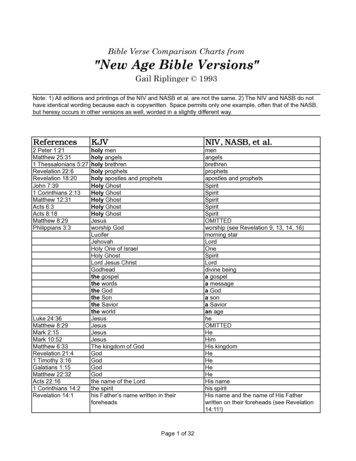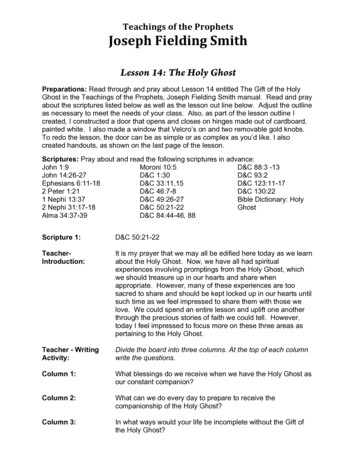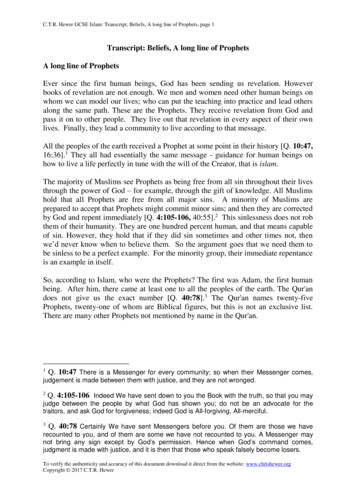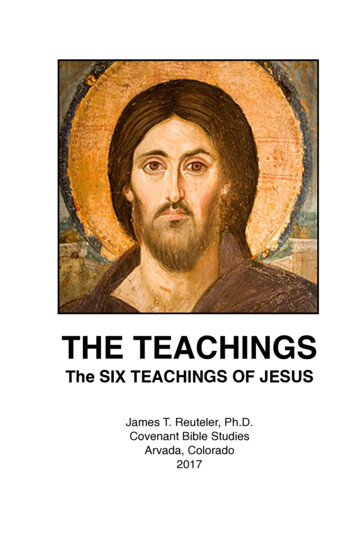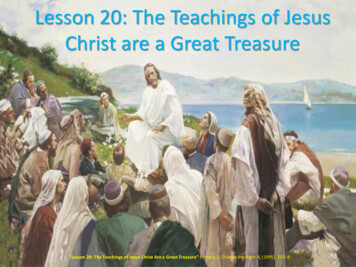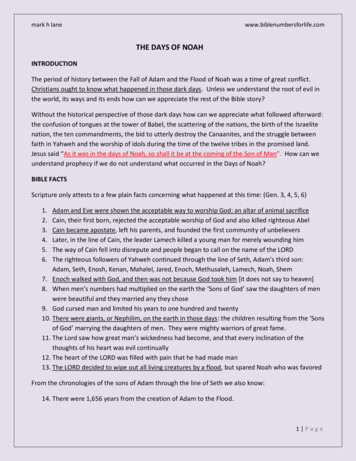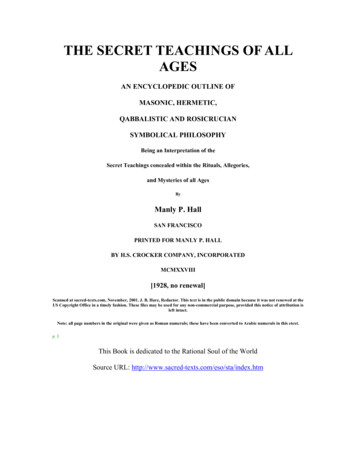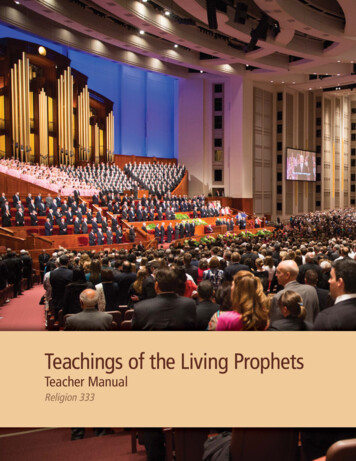
Transcription
Teachings of the Living ProphetsTeacher ManualReligion 333Published byThe Church of Jesus Christ of Latter-day SaintsSalt Lake City, Utah
Comments and corrections are appreciated. Please send them, including errors, to:Seminaries and Institutes of Religion Curriculum Services50 E North Temple StreetSalt Lake City, Utah 84150-0008USAEmail: ces-manuals@ldschurch.orgPlease list your complete name, address, ward, and stake.Be sure to give the title of the manual when you offer your comments. 2010, 2016 by Intellectual Reserve, Inc.All rights reserved.Printed in the United States of AmericaVersion 2, 12/16English approval: 10/1614420
ContentsIntroduction . . . . . . . . . . . . . . . . . . . . . . . . . . . . . . . . . . . . . . . . . v1 Our Need for Living Prophets . . . . . . . . . . . . . . . . . . . . . . . . . . . . 12 The Living Prophet: The President of the Church . . . . . . . . . . . . . . . . . 83 Succession in the Presidency . . . . . . . . . . . . . . . . . . . . . . . . . . . 134 The Quorum of the First Presidency . . . . . . . . . . . . . . . . . . . . . . . 195 The Quorum of the Twelve Apostles . . . . . . . . . . . . . . . . . . . . . . . 256 General Conference . . . . . . . . . . . . . . . . . . . . . . . . . . . . . . . . . 297 Studying General Conference Addresses . . . . . . . . . . . . . . . . . . . . 34
IntroductionElder Robert D. Hales of the Quorum of the Twelve Apostles declared:“Living prophets are leading this church today. The greatest security of membersof The Church of Jesus Christ of Latter-day Saints comes from learning to listen toand obey the words and commandments that the Lord has given through livingprophets. I would hope that the world would understand the importance ofhaving a living prophet on earth today” (Robert D. Hales, “Hear the Prophet’sVoice and Obey,” Ensign, May 1995, 17).As the teacher for this course, you have the opportunity of helping your studentsrecognize the blessing of living in a day when living prophets are upon the earth.You can help them know that Heavenly Father speaks today as He has in alldispensations. When the living prophets speak in an authoritative capacity to themembers of the Church, what they say is “the mind of the Lord, the voice of theLord, and the power of God unto salvation” (D&C 68:4).Prayerfully study the scriptures and general conference addresses. Seek the HolySpirit as you choose learning activities that help students grow spiritually. Helpstudents discover, understand, and live the truths presented in the conferences ofthe Church.This manual supplements your preparation by providing introductory informationto the chapters, identifying scriptures and gospel principles, and suggesting waysyou can help students understand the doctrine and apply it in their lives.How This Manual Is OrganizedReligion 333 is designed to be taught in a single semester. This manual containsseven chapters:1. Our Need for Living Prophets2. The Living Prophet: The President of the Church3. Succession in the Presidency4. The Quorum of the First Presidency5. The Quorum of the Twelve Apostles6. General Conference7. Studying General Conference AddressesThe first six chapters include content and insights that you can use as a resource asyou teach the doctrinal foundations for this class. As the teacher you have theflexibility to teach these lessons the first six class periods of the semester or tospread them throughout the semester. Chapter 7 provides ideas on multiplemethods for teaching the words of the General Authorities from the most recentconference issue of the Ensign or Liahona magazine. The remaining class periodsshould be taught from the conference issue.v
I N T RO D UC T I O NThe lessons in this manual are designed to last 50 minutes. If your class meets twicea week, each lesson should last approximately 50 minutes. If you meet only once aweek, each lesson should last approximately 90 minutes. For a 90-minute class youmight teach one of the lessons from this manual as well as material from the Ensignor Liahona. You will need to adapt the course material to your individual teachingcircumstances. During a typical semester, instruction from the Ensign or Liahonawill constitute approximately 75 percent of the classroom time.Each chapter in this manual has three sections: Introduction Some Doctrines and Principles Ideas for TeachingIntroductionThe “Introduction” section highlights general themes contained in the chapter andwill help you gain a quick vision of the overall topic.Some Doctrines and PrinciplesThe section called “Some Doctrines and Principles” contains a list of centraldoctrines and principles related to that lesson topic. In addition to the doctrinesand principles identified in the manual, you might find other important truths inthe scriptures or conference issues of the Ensign or Liahona that you feel meet theneeds of your students. This is your prerogative as the teacher. However, you maywant to survey the other chapters in the manual before teaching additionalprinciples. If a principle or doctrine is not addressed in the suggested lessonmaterial, it may be presented in another chapter that supports the topic morecompletely.Ideas for TeachingThe “Ideas for Teaching” section provides a specific teaching idea for each of theitems identified under “Some Doctrines and Principles.” This section may alsocontain teaching suggestions for significant ideas not listed under “Some Doctrinesand Principles.” These “Ideas for Teaching” help you prepare lesson material andlearning activities. Adapt the lesson suggestions to fit the classroom environment,student needs, and time constraints.Other Teaching HelpsCommentary in the student manual. The Teachings of the Living Prophets StudentManual (Religion 333) contains valuable commentary by General Authorities andGeneral Officers of the Church. Several teaching ideas in the teacher manual referyou to the commentary found in the student manual. Encourage students to usethis resource both in and outside of class. Furthermore, each chapter of the studentmanual concludes with a “Points to Ponder” and “Suggested Assignments” section.The questions under “Points to Ponder” and the activities in “SuggestedAssignments” help students consider more carefully the supplemental readings.Many of these questions and activities can also be adapted into teaching ideas foruse in class.vi
IN T R O DUCTIONWords of the living prophets, General Authorities, and General Officers ofthe Church. As you study current talks given in general conference and articles inChurch magazines, look for additional material that could supplement the lessonsin this manual.Seminaries and Institutes of Religion website. Seminaries and Institutes ofReligion also has a website, institute.lds.org, with many resources that mayhelp you.How to Use This ManualUse the general conference addresses of the First Presidency and the Quorum ofthe Twelve Apostles extensively to supplement this manual as you prepare lessonsand present information in class. Messages by members of the First Presidency andQuorum of the Twelve Apostles found in Church magazines, talks given on otheroccasions, or official communications that are periodically sent out by the Brethrenmay also be considered.The manual could be used in several ways, including the following:1. You may choose to closely follow the teaching suggestions as outlined.2. You may use this manual as a study guide to identify principles and themes youwant to develop in your lesson.Decide What You Will TeachChoose doctrines, principles, events, and applications that are most important foryour students to know and do. Much of what you teach will come from this manualand the student manual; however, be sure to consider using scriptures tosupplement the principles from the manuals. Let the promptings of the Holy Ghostand the needs of your students guide you as you decide what to teach. (For moreinformation on what to teach, see Gospel Teaching and Learning: A Handbook forTeachers and Leaders in Seminaries and Institutes of Religion [2012], section 4.3.3.)You are not obligated to teach all of the suggested doctrine and principles in eachchapter, and you will likely find that you do not have the time to do so. ElderRichard G. Scott (1928–2015) of the Quorum of the Twelve Apostles counseled:“Remember, your highest priority is not to get through all the material if thatmeans that it cannot be properly absorbed. Do what you are able to do withunderstanding” (Richard G. Scott, “To Understand and Live Truth” [address toCES religious educators, Feb. 4, 2005], 2).Decide How You Will TeachRemember the role of the student as you select different teaching methods for alesson. Speaking to religious educators, President J. Reuben Clark Jr. (1871–1961)stated, “You do not have to sneak up behind this spiritually experienced youth andwhisper religion in his ears” (“The Charted Course of the Church in Education”[address to seminary and institute of religion leaders, Aug. 8, 1938], 6). You canvii
I N T RO D UC T I O Nexpect students to be spiritually mature and to take their role as learners seriously.When organizing your lesson, help your students take responsibility for theirlearning. The following suggestions may be helpful: Encourage students to read assigned sections of the student manual or generalconference addresses and corresponding scriptures before each lesson. Give students the opportunity to ask and answer questions. Good questions area valuable tool in helping students take responsibility for their learning. Youmay want to occasionally invite students to come to class with a questionwritten down. Help students see that the questions they ask in class may proveto be more important in the learning process than questions asked by theteacher. As they study the teachings of the living prophets, encourage studentsto identify principles, explain meanings, share insights, and bear testimony ofthe truths they learn. Create an environment where students feel the Spirit ofthe Lord and have the privilege and responsibility to listen and speak to edifyone another (see D&C 88:122). Look for opportunities to use key passages of scripture as a second and thirdwitness to the principles you teach from the curriculum. Allow time for studentsto identify verses of scripture that add insight or witness to the principlesbeing taught. Avoid using lecture as the only teaching method. Instead, allow students todiscover truths by guiding them to truths you and others have found. ElderDavid A. Bednar of the Quorum of the Twelve Apostles taught that effectiveteachers help students find answers for themselves:“I have observed a common characteristic among the instructors who havehad the greatest influence in my life. They have helped me to seek learningby faith. They refused to give me easy answers to hard questions. In fact,they did not give me any answers at all. Rather, they pointed the way andhelped me take the steps to find my own answers. I certainly did not alwaysappreciate this approach, but experience has enabled me to understand thatan answer given by another person usually is not remembered for very long, if rememberedat all. But an answer we discover or obtain through the exercise of faith, typically, is retainedfor a lifetime” (David A. Bednar, “Seek Learning by Faith,” Ensign, Sept. 2007, 67).Rather than disseminate information through lecture only, look for teachingmethods that will help students take a more active role in the learning process.(For more information on how to teach, see Gospel Teaching and Learning: AHandbook for Teachers and Leaders in Seminaries and Institutes of Religion [2012],section 4.3.4.) Invite students to apply the counsel of the prophets. Help them becomedisciples of Jesus Christ and not just gospel scholars. Elder David A. Bednarfurther counseled us to help students go “beyond mere cognitivecomprehension and the retaining and recalling of information” in order to helpthem “put off the natural man (see Mosiah 3:19), to change [their] hearts (seeMosiah 5:2)” (“Seek Learning by Faith,” 64).viii
IN T R O DUCTIONAdapting the Manual to Those with DisabilitiesWhen teaching students with disabilities, adapt the lessons to meet their needs. Forexample, many lessons require students to read either aloud or silently and to writeresponses on paper. To adapt to nonreading students, you might consider readingaloud yourself, having fellow students read, or using prerecorded materials tonarrate the scriptures (such as an audiotape, CD, or mp3). When lessons call forwritten responses, you might encourage oral responses instead.For more ideas and resources, go to disabilities.lds.org and the section in theSeminaries and Institutes of Religion Policy Manual on “Adapting Classes andPrograms for Students with Disabilities.”ix
CHAPTER 1Our Need for LivingProphetsIntroductionWe live in a day of tremendous opportunities, trials, andtemptations. Though great help can be found in the words ofpast prophets, we are in need of the Lord’s continuingguidance fit to the circumstances in which we live. PresidentJohn Taylor (1808–87) taught:“We require a living tree—a living fountain—livingintelligence, proceeding from the living priesthood in heaven,through the living priesthood on earth. It always requirednew revelations, adapted to the peculiar circumstances inwhich the churches or individuals were placed.“Adam’s revelation did not instruct Noah to build his ark; nordid Noah’s revelation tell Lot to forsake Sodom; nor did eitherof these speak of the departure of the children of Israel fromEgypt. These all had revelations for themselves. And somust we” (Teachings of Presidents of the Church: John Taylor[2001], 158).This chapter is designed to help your students understandtheir need for living prophets and the blessings we receive byheeding their counsel.Some Doctrines andPrinciples The Lord reveals His will to livingprophets now as He did in the past. The Lord’s Church is built on thefoundation of prophets andapostles. The members of the First Presidencyand the Quorum of the TwelveApostles are prophets, seers, andrevelators. Prophets help us build faith inJesus Christ. Safety comes in knowing andapplying the teachings of the livingprophets.The First VisionIdeas for TeachingThe Lord Reveals His Will to Living Prophets Now as He Did in the PastShare with your class the statement by President Hugh B. Brown (1883–1975) ofthe First Presidency about the need for living prophets from section 1.1 of Teachingsof the Living Prophets Student Manual.Read Amos 3:7 as a class and ask: How does Amos 3:7 reinforce what President Brown taught?1
CHAPTER 1Write the following references on the board: 1 Nephi 2:1–3; Exodus 3 chaptersummary. Invite students to read one of the references and identify what the Lordasked the people to do and who received the revelation. Briefly discuss theirfindings.Invite a student to read the statement by President John Taylor (1808–87) insection 2.4 of the student manual. Then discuss the reasons President Taylor gavefor the need of living prophets.To emphasize that the Lord reveals to living prophets the counsel and instructionwe need in our day, write the word pornography on the board. Share with studentsthat the first time the word pornography was used in general conference was inOctober 1959. Over the next 10 years, from 1959 to 1969, it was mentioned 8 timesin conference. However, for the 10-year period from 1999 to 2009 it was mentionedor discussed 81 times in general conference. Ask students the following questions: Why do you think there has been such a dramatic change in the number ofreferences to pornography by the Brethren? (Be cautious not to allow this toturn into a detailed discussion on pornography; it is simply one example of theneed for living prophets based on changing circumstances.) What other examples are there of important truths or counsel received in ourday through living prophets that may not have been emphasized so much byprophets of the past? (Write students’ answers on the board for reference laterin the lesson. Answers might include family home evening or warnings againstdrug abuse, abortion, and homosexuality.)Share the following statement by President Henry B. Eyring of the FirstPresidency:“Revelation and inspiration have come to [President Thomas S. Monson] in mypresence. I am an eyewitness” (Henry B. Eyring, “The True and Living Church,”Ensign or Liahona, May 2008, 24).Ask: Why is it important to know that the Lord continues to reveal His mind and willthrough living prophets?Testify of the need for living prophets in the world today and that the Lordcontinues to reveal His mind and will through His chosen prophets.2
CHAP TER 1The Lord’s Church Is Built on the Foundation of Prophets and ApostlesDraw the accompanying diagram onthe board and ask students thefollowing question: Knowing the value of a solidfoundation, what difference doesthe type of building material makein a foundation?Invite students to read Matthew7:24–27.Share the following statement by President Russell M. Nelson of the Quorum ofthe Twelve Apostles:“About two decades ago when a temple was to be built in Mexico City, architectsfaced a great challenge. Because Mexico City is situated on a basin over water,some of its buildings settle and become tilted with the passage of time.Construction of a temple there required a special foundation. Two hundredtwenty-one large, reinforced concrete piles [each pile was 18 inches in diameter]were driven more than 100 feet deep into the ground. With this unseen butsure foundation, that temple today stands steady and straight.“A firm foundation is necessary for any building, institution, or individual to endure. With that inmind, let us consider the foundation of The Church of Jesus Christ of Latter-day Saints. Then let ussee how the solid foundation of the Church supports our foundation of faith as individualmembers of the Church” (Russell M. Nelson, “How Firm Our Foundation,” Ensign, May2002, 75).Read Ephesians 2:19–21 aloud with the class and use the following questions tohelp students compare the foundation of the Mexico City Temple to the Church’sfoundation of prophets and apostles: In what ways is the foundation of prophets and apostles similar to the largepilings used to secure the Mexico City Temple? What can a person do to be sure he or she is building a strong foundation?Explain that the Apostle Paul gave some reasons for the foundation of prophets andapostles. Ask a student to read Ephesians 4:11–14. Have the rest of the studentslook for reasons why the Lord gave prophets and apostles as our foundation.Discuss students’ findings.Invite a student to read the statement by Elder Jeffrey R. Holland of the Quorumof the Twelve Apostles from section 1.4 of the student manual. Ask students thefollowing questions: According to Elder Holland, why is a foundation of prophets and apostles sovital today? What is an example of a teaching from one of the prophets and apostles fromthe most recent general conference that has helped strengthen your foundationof faith?3
CHAPTER 1 How can adherence to that teaching or other teachings you recall fromconference help prevent you from being “tossed to and fro with every windof doctrine” (Ephesians 4:14) in today’s world?The Members of the First Presidency and the Quorum of the Twelve ApostlesAre Prophets, Seers, and RevelatorsHold up a picture of the President of the Church.Remind the students that during our ward, stake, and general conferences we raiseour right hands to the square to manifest that we sustain the General Authorities.Ask students the following questions: What is the wording used when we sustain the President of the Church?(Prophet, seer, and revelator.) Is there anyone else we sustain in that same language? What is the advantage of having more than one man with that authority?Invite a student to read the statement by President Harold B. Lee (1899–1973)from section 1.5 of the student manual. Ask: When the prophet passes away, who has the authority to serve as the nextPresident of the Church?Write the word prophet on the board. Ask students to read the entry in the BibleDictionary for the word prophet. Then ask them to work with another person inclass to come up with a brief definition for the word. Invite several students toshare their definitions.Have the students turn to section 1.6 of the student manual and read theinformation under the subheading “Prophet” (section 1.6.1). Invite students topoint out any specific words or phrases that further explain what a prophet is andwhat he does.Divide the class into two groups, and instruct them to keep their student manualsopen to section 1.6. Assign one group to review the information under thesubheading “Seer” (section 1.6.2) and the other group to review the informationunder the subheading “Revelator” (section 1.6.3).After sufficient time for review and study, ask each group to choose aspokesperson. Invite this spokesperson to teach the rest of the class how a seer or arevelator is different from a prophet. Encourage them to share their feelings andtestimony about why seers and revelators are important today. If any students havepersonally met an Apostle (a prophet, seer, and revelator) or attended a meetingwhere an Apostle has spoken in person, encourage them to relate the experienceand any feelings they had.Prophets Help Us Build Faith in Jesus ChristRead Doctrine and Covenants 1:17 with your class and ask: What reason did the Lord state for calling the Prophet Joseph Smith?Read Doctrine and Covenants 1:21 with your class and ask:4
CHAP TER 1 What additional reason did the Lord state for needing Joseph Smith in thelast days? How has your knowledge of the life and teachings of Joseph Smith increasedyour faith? How has your knowledge of the life and teachings of other prophets of theChurch increased your faith?Safety Comes in Knowing and Applying the Teachings of the Living ProphetsTo help students consider how safety comes through hearkening to livingprophets, you may want to show students the video “Watchman on theTower” (4:17), found on Doctrine and Covenants and Church History Visual ResourceDVDs and on LDS.org. This video addresses how safety comes through hearkeningto living prophets.Bring a container of cleaning liquid (or any other item that contains a warning onthe label) and read the warning on the label to the class. Ask: What could happen if the container did not have a warning label or if a persondid not heed the warning on the label? What parallels do you see between the label on the cleaning bottle and theteachings of a prophet?Point out that some people might use the cleaning liquid incorrectly and injurethemselves because they don’t know about the warning, while others who do knowabout the warning but don’t apply that knowledge will experience the same injury. How could the above scenario for misuse of a cleaning liquid be applied to ourprophets today?Invite a student to read Doctrine and Covenants 1:2–4. Ask the rest of yourstudents to identify how the Lord will warn us in the latter days. Then ask thefollowing questions: Who are the “disciples” of the Lord in our day? How does this warning compare to the warning on the cleaning liquid?Invite a student to read the statement by President Harold B. Lee (1899–1973) insection 1.10 of the student manual. Ask: According to President Lee, what is a key to safely making our way through thechallenges of life? What can we do to ensure that we are seeing the “warning labels” given bylatter-day Apostles in the challenges of life today?Read to your students the following statement from President Henry B. Eyring ofthe First Presidency:5
CHAPTER 1“Because the Lord is kind, He calls servants to warn people of danger. That call towarn is made harder and more important by the fact that the warnings of mostworth are about dangers that people don’t yet think are real” (Henry B. Eyring,“A Voice of Warning,” Ensign, Nov. 1998, 32).Ask students: How are prophets able to perceive dangers that others fail to perceive? (Ifstudents don’t bring it up, this may be an appropriate place to bear witness ofthe role of seers—they see things through revelation that others don’t see.)Read the following statement by Elder M. Russell Ballard of the Quorum of theTwelve Apostles:“When we hear the counsel of the Lord expressed through the words of thePresident of the Church, our response should be positive and prompt. History hasshown that there is safety, peace, prosperity, and happiness in responding toprophetic counsel” (M. Russell Ballard, “His Word Ye Shall Receive,” Ensign, May2001, 65).Ask students the following questions: What are reasons some people give for ignoring the warnings we receive fromthe Brethren? What difference would it make to respond to the warnings and counsels of theprophets and apostles in the way that Elder Ballard described?Ask your students to look at the list on the board that the class made earlier ofimportant truths revealed by our living prophets. The Brethren invest hugeamounts of time, effort, and money to provide general conference; their intent isthat the messages, prayers, and music will help us improve our lives. Ask the class: What must the Brethren do to ensure this will happen? (Answers might includebeing well prepared, being inspired about what subjects to address, and speakingunder the influence of the Holy Ghost.) What is my responsibility in this process? (Answers might include listening,praying for the Brethren who are speaking, praying to be receptive, taking notes, beingfree of interruption during the conference, and being in tune with the Holy Ghost.)Allow enough time for students to think about their answers and make some goals.Arrange students in pairs. Have each pair study Doctrine and Covenants 21:4–6and then discuss the following questions (you could write these questions on theboard before class):6
CHAP TER 1 What doctrine is taught in these verses? Why does it sometimes take faith and patience to heed the counsel of aprophet? What promises are made to those who give heed to the words andcommandments of the prophet?Share with your class the following statement by President Henry B. Eyring ofthe First Presidency:“Looking for the path to safety in the counsel of prophets makes sense to thosewith strong faith. When a prophet speaks, those with little faith may think thatthey hear only a wise man giving good advice. “ But the choice not to take prophetic counsel changes the very ground uponwhich we stand. It becomes more dangerous. The failure to take propheticcounsel lessens our power to take inspired counsel in the future” (Henry B.Eyring, “Finding Safety in Counsel,” Ensign, May 1997, 25).Ask students the following questions: Why would “the very ground upon which we stand” become “more dangerous”when we reject the counsel of the prophet? What are some examples of counsel the prophet has given during your lifetimethat addresses modern-day concerns? (List the students’ answers on the board.Answers might include pornography, gambling, divorce, forgiving others, pride,reading the Book of Mormon, or other counsel.)Give each student a sheet of paper. Invite them to select one of the answers listedon the board and write a paragraph describing how heeding this counsel will bringspiritual safety and “will disperse the powers of darkness” (D&C 21:6) in their lives.Invite several students to share what they wrote. For those students who share theirresponse, consider asking them a follow-up question such as: When have you felt the truthfulness of this teaching in your life? How could you teach and testify of this principle to a family member or friend?Help students understand that once we recognize the importance of livingprophets in our lives, we must act decisively to apply their teachings to our lives.The Lord has sent prophets to help keep us spiritually safe.7
CHAPTER 2The Living Prophet: ThePresident of the ChurchIntroductionThe keys the President of the Church exercises in his role asprophet, seer, and revelator set him apart from everyone elseon earth. The prophet’s inspired counsel will always be inharmony with eternal truths and will be focused on the needsand conditions of his day. Heeding his counsel has eternalimplications. Help your students know that as they placeconfidence and trust in the counsel of the living prophet, theywill be led to paths of safety. While serving as a member ofthe Quorum of the Twelve Apostles, President Gordon B.Hinckley (1910–2008) declared:“I am satisfied that the peace and the progress and theprosperity of this people lie in doing the will of the Lord asthat will is articulated by [the President of the Church]. If wefail to observe his counsel, we repudiate his sacred calling. Ifwe abide his counsel, we shall be blessed” (Gordon B.Hinckley, “We Thank Thee, O God, for a Prophet,” Ensign,Jan. 1974, 125).Some Doctrines andPrinciples The President of the Church holdsand directs the use of all the keys ofthe priesthood. The teachings and directions of theliving prophet take precedence overwhat former prophets have said. The Lord will never permit theliving prophet to lead theChurch astray.Ideas for TeachingThe President of the Church Holdsand Directs the Use of All the Keysof the PriesthoodPresident Gordon B. Hinckley (left), PresidentEzra Taft Benson (center), and PresidentThomas S. Monson (right)Invite a student turn to section 2.1 ofTeachings of the Living Prophets Student Manual, and ask him or her to read the firstfour paragraphs (up through “we use them every day”) of the account by PresidentBoyd K. Packer (1924–2015) of the Quorum of the Twelve Apostles.Then study Matthew 16:15–19; 18:18 with your students. Ask: What did the Savior say He would give unto
teacher. As they study the teachings of the living prophets, encourage students to identify principles, explain meanings, share insights, and bear testimony of the truths they learn. Create an environment where students feel the Spirit of the Lord and have the privilege and responsibility to listen and speak to edify one another (seeD&C 88:122).

